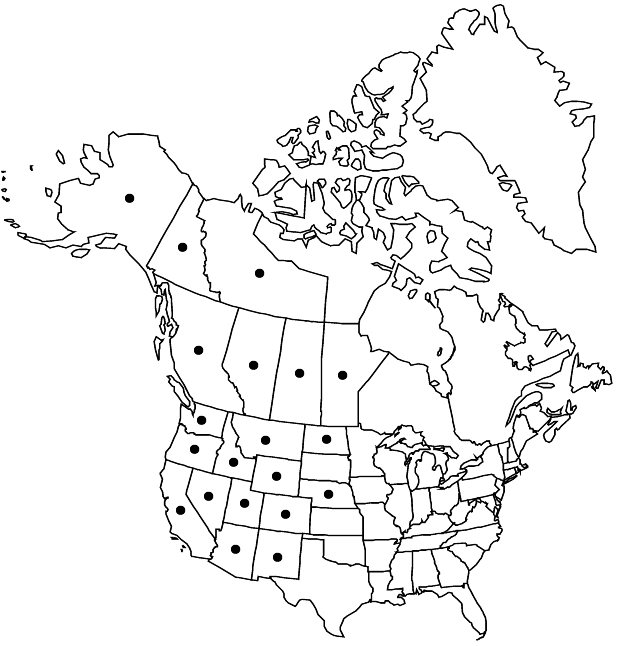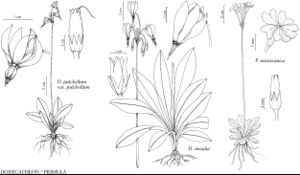Difference between revisions of "Dodecatheon pulchellum var. pulchellum"
FNA>Volume Importer |
FNA>Volume Importer |
||
| Line 46: | Line 46: | ||
|discussion=<p>Variety pulchellum is the most widespread and common variant of the species. It ranges from south-eastern Alaska and western Canada, to southeastern Manitoba, to Lassen County, California, northern and eastern Arizona, New Mexico, and northern Mexico. Scattered populations are found in western North Dakota (Burke County) and in western Nebraska (Morrill County). A collection at Fort Lewis, Thurston County, Washington (D. Thysell 705, WTU), may be an introduction.</p><!-- | |discussion=<p>Variety pulchellum is the most widespread and common variant of the species. It ranges from south-eastern Alaska and western Canada, to southeastern Manitoba, to Lassen County, California, northern and eastern Arizona, New Mexico, and northern Mexico. Scattered populations are found in western North Dakota (Burke County) and in western Nebraska (Morrill County). A collection at Fort Lewis, Thurston County, Washington (D. Thysell 705, WTU), may be an introduction.</p><!-- | ||
--><p>Relatively small, usually high-elevation plants in southeastern British Columbia, Idaho, western Montana, northeastern <i>Nevada</i>, and western Wyoming have been segregated as var. watsonii. The origin of a similar specimen, supposedly from Mount Arrowsmith on Vancouver Island (collector unknown, UBC) remains to be confirmed. In Montana and northwestern Wyoming, such plants can be easily confused with the sparsely glandular <i>Dodecatheon conjugens</i>, which also has transverse rugose (not smooth or longitudinally wrinkled) connectives.</p><!-- | --><p>Relatively small, usually high-elevation plants in southeastern British Columbia, Idaho, western Montana, northeastern <i>Nevada</i>, and western Wyoming have been segregated as var. watsonii. The origin of a similar specimen, supposedly from Mount Arrowsmith on Vancouver Island (collector unknown, UBC) remains to be confirmed. In Montana and northwestern Wyoming, such plants can be easily confused with the sparsely glandular <i>Dodecatheon conjugens</i>, which also has transverse rugose (not smooth or longitudinally wrinkled) connectives.</p><!-- | ||
| − | --><p>Plants with leaves to 25 cm wide may be seen along the Front Range of the Rocky Mountains in Colorado and in north-central New Mexico; this phase was named <i>Dodecatheon</i> radicatum. Some populations from Alberta (the type location of <i>D. pulchellum</i>) have similar leaves. Plants with yellow pollen sacs occur in some populations on the Great Plains in Alberta, Manitoba, and Saskatchewan, gradually becoming more common eastward. A collection from the Sierra Madre, Durango, Mexico (E. W. Nelson 4780, K, US) is allied to <i></i>var.<i> pulchellum</i>. Some populations east of the Alaska Range and in adjacent northern Yukon, here assigned to <i></i>var.<i> pulchellum</i>, have minutely glandular calyces, pedicels, nodes, and uppermost portion of scapes. The taxonomic significance of these plants has not been determined; they may indicate some past introgression with <i>D. frigidum</i>.</p> | + | --><p>Plants with leaves to 25 cm wide may be seen along the Front Range of the Rocky Mountains in Colorado and in north-central New Mexico; this phase was named <i>Dodecatheon</i> radicatum. Some populations from Alberta (the type location of <i>D. pulchellum</i>) have similar leaves. Plants with yellow pollen sacs occur in some populations on the Great Plains in Alberta, Manitoba, and Saskatchewan, gradually becoming more common eastward. A collection from the Sierra Madre, Durango, Mexico (E. W. Nelson 4780, K, US) is allied to <i></i></i>var.<i><i> pulchellum</i>. Some populations east of the Alaska Range and in adjacent northern Yukon, here assigned to <i></i></i>var.<i><i> pulchellum</i>, have minutely glandular calyces, pedicels, nodes, and uppermost portion of scapes. The taxonomic significance of these plants has not been determined; they may indicate some past introgression with <i>D. frigidum</i>.</p> |
|tables= | |tables= | ||
|references= | |references= | ||
| Line 70: | Line 70: | ||
|publication year= | |publication year= | ||
|special status= | |special status= | ||
| − | |source xml=https://jpend@bitbucket.org/aafc-mbb/fna-data-curation.git/src/ | + | |source xml=https://jpend@bitbucket.org/aafc-mbb/fna-data-curation.git/src/f6b125a955440c0872999024f038d74684f65921/coarse_grained_fna_xml/V8/V8_568.xml |
|genus=Dodecatheon | |genus=Dodecatheon | ||
|species=Dodecatheon pulchellum | |species=Dodecatheon pulchellum | ||
Revision as of 20:29, 24 September 2019
Plants usually glabrous. Leaves (3–)4–17(–25) × 0.5–2.5(–4.5) cm; blade oblanceolate to spatulate. Pedicels usually glabrous, rarely glandular. Flowers: calyx usually glabrous, rarely glandular; corolla tube yellow with maroon, thin, wavy ring, lobes magenta to lavender, (5–)7–15(–18) mm; filament tube usually yellow, rarely magenta, 1.8–3.6 mm; anthers 3.5–5 mm; pollen sacs usually maroon, rarely yellow, connective maroon. 2n = 44.
Phenology: Flowering spring–summer.
Habitat: Moist, sometimes saline or even alkaline flats and slopes usually in meadows, grassy places, or under conifers, sometimes in boggy or marshy places with birch, willow, or aspen
Elevation: 400-3500 (-4100) m
Distribution

Alta., B.C., Man., N.W.T., Sask., Yukon, Alaska, Ariz., Calif., Colo., Idaho, Mont., Nebr., Nev., N.Mex., N.Dak., Oreg., Utah, Wash., Wyo., Mexico (Chihuahua, Durango).
Discussion
Variety pulchellum is the most widespread and common variant of the species. It ranges from south-eastern Alaska and western Canada, to southeastern Manitoba, to Lassen County, California, northern and eastern Arizona, New Mexico, and northern Mexico. Scattered populations are found in western North Dakota (Burke County) and in western Nebraska (Morrill County). A collection at Fort Lewis, Thurston County, Washington (D. Thysell 705, WTU), may be an introduction.
Relatively small, usually high-elevation plants in southeastern British Columbia, Idaho, western Montana, northeastern Nevada, and western Wyoming have been segregated as var. watsonii. The origin of a similar specimen, supposedly from Mount Arrowsmith on Vancouver Island (collector unknown, UBC) remains to be confirmed. In Montana and northwestern Wyoming, such plants can be easily confused with the sparsely glandular Dodecatheon conjugens, which also has transverse rugose (not smooth or longitudinally wrinkled) connectives.
Plants with leaves to 25 cm wide may be seen along the Front Range of the Rocky Mountains in Colorado and in north-central New Mexico; this phase was named Dodecatheon radicatum. Some populations from Alberta (the type location of D. pulchellum) have similar leaves. Plants with yellow pollen sacs occur in some populations on the Great Plains in Alberta, Manitoba, and Saskatchewan, gradually becoming more common eastward. A collection from the Sierra Madre, Durango, Mexico (E. W. Nelson 4780, K, US) is allied to var. pulchellum. Some populations east of the Alaska Range and in adjacent northern Yukon, here assigned to var. pulchellum, have minutely glandular calyces, pedicels, nodes, and uppermost portion of scapes. The taxonomic significance of these plants has not been determined; they may indicate some past introgression with D. frigidum.
Selected References
None.
